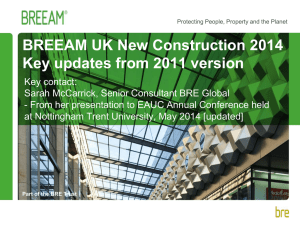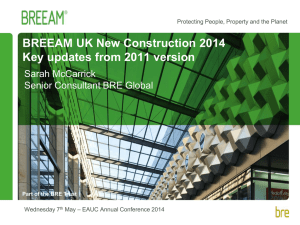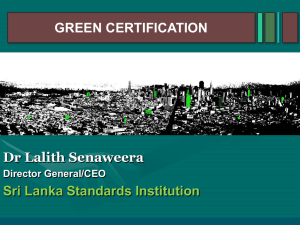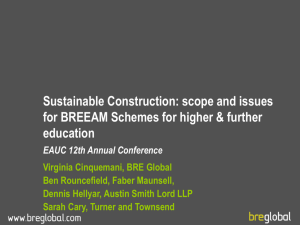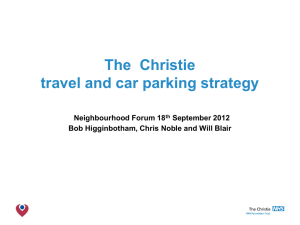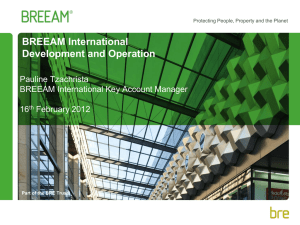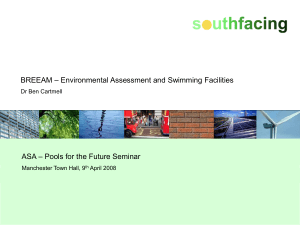Title of presentation
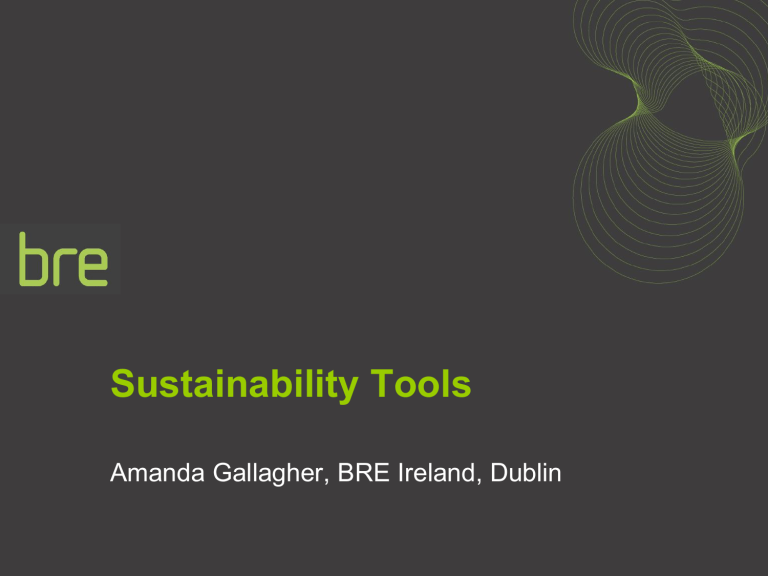
Sustainability Tools
Amanda Gallagher, BRE Ireland, Dublin
Contents
Sustainability Tools
• Developments & Masterplans
• Buildings
• Energy
• Materials
• Waste
• Post Occupancy Evaluation
Sustainability Issues in the Built Environment
Site
Selection
Greenfield or
Brownfield Site
Impact on Natural
Habitat
Existing infrastructure
(roads/energy/tran sport networks)
Proximity to amenities and populated areas
Economic centres/creation of jobs
Probability of
Flooding
Noise
Assessment
Stakeholder
Consultation
Orientation
Planning &
Design
Low Carbon Design
Placemaking &
Community
Water Conservation
Life Cycle Costing
Fitness for Purpose
Lighting
Heating
Ventilation
Infrastructure
Travel Plans
Material
Specification
Site Ecology &
Landscape Design
Flood Risk
Prevention
Polluting Chemicals and Substances
Construction
Construction Site
Impacts
•
Site Waste Management
•
Energy & Water Use
• Transport Emissions
•
Dust & Pollution
Considerate
Constructors
Sustainable Materials
Recycled Aggregates
Local
Labour/Workforce
Building
Operation
Commissioning and Building
Handover
Building User
Guide
Energy Use
Water Use
Maintainability
Durability
User Controls
Occupant
Satisfaction
Occupant
Productivity (non domestic buildings)
Acoustic
Performance
Demolition
Recyclable
Materials
Demolition Audits
Disposal of
Materials
Avoiding obsolescence
Flexibility
Hazardous
Materials
Why do we need specific guidance on sustainability?
• Definitions are not always that helpful in practice:
–
Sustainable buildings definition (SBTG):
“…as small an eco-footprint as possible, economic to run over its whole life cycle and fits well with the needs of the local community”
• Need to define what you want to achieve in your context
• Education, training and awareness raising
• Means of assessing design options and applications
• Level playing field for developers
• Showing the future direction of policy
How can sustainability tools help?
• Developers / architects / design teams:
– What is the range of issues to consider?
– How are they linked together?
– What standards and advice are out there?
– What might decision makers expect?
– What does good practice look like – marketing opportunities?
– How can I do more – simple “wins”?
– What might I have to consider in the future?
Sustainability Assessment Tools
Development
Tools
• Masterplanning/Developments
– Sustainability Checklists
– Greenprint
– BREEAM Communities
• Buildings
– BREEAM/Code for Sustainable Homes
– LEED/Greenstar
– Energy (SBEM/SAP, PHPP etc. etc.)
– Environmental Design and Life Cycle Assessment Tool (ENVEST)
– Materials (Environmental Profiles & Green Guide to Specification)
– Construction site waste (Smart Waste)
• Post Occupancy Evaluation
Sustainability in Masterplans & Developments.
• Sustainability Checklists for Developments
• Greenprint
• BREEAM Communities
What can Sustainability Checklists cover?
• Site choice
– Greenfield, destruction of natural habitat
• Development design and layout
– Regional Sustainability Checklists / Climate Change Tool kits / DQIs
• Individual building performance
– BREEAM / Ecohomes
• Elements of construction process
– ICE Demolition Protocol
• Procurement
– The OGC Achieving Excellence Procurement Guide
• Post-build operation and management
– BRE/Carbon Trust / EST guides
… and any combination!
Scored sustainability checklist - question:
Objective
Question 1.4 (2)
Targets
To ensure that roof space is used productively to minimise water demand and manage water run-off on the site.
What percentage of the total roof area in the development is designed to allow the harvesting of rain water for re-use and/or is covered by green roofs?
Minimum See relevant local planning authority standard for minimum required.
Mark for target reached:
1
Good practice 2
Best practice
50% of the roof area used for rainwater harvesting or green roofs
More than 50% of the roof area used for rainwater harvesting or green roofs; captured water used for irrigation and /or toilet flushing and/or washing machines
3
Minimum not met
Considered not applicable for this application:
(a) mark awarded for this question:
0
0
(b) Question weighting: 0.4
Total Question score: (a) x (b): 0
Justification
Link s to the
RSS/ IRF RSS) CC2 Climate Change, CC3 Resource use
What we have learned in other work:
• Checklists are an increasingly common approach.
• SEEDA/BRE regional checklist recognised as part of the Sustainable
Communities agenda – Egan Commission and SBTG recommended that it should be rolled out to all regions in England (extensive tailoring now underway in each region).
• Developers will not fill them in unless required to – must be a level playing field.
• Need to quantify what you want – or specify a process. Ecobuild conference reiterated this from both architects and developers. Level playing field issue again.
• Minimum, good and best practice scoring enable higher standards to be easily specified for more sensitive sites.
GreenPrint -
Bringing it all together
Climate Change
Buildings
Resources
Community
Placemaking
Ecology
Transport
Business
What is GreenPrint?
• Methodology to maximise the potential for sustainable communities
• Workshop led approach involving the whole stakeholder team
• Bespoke – can be tailored to individual client needs
• Sets out clear understandable sustainability objectives and benchmarks
• Prioritises sustainability issues most important to a development
• Independent appraisal of final plans
• Provides an overall GreenPrint Score and Rating
BREEAM Communities
• Similar to Greenprint but ‘fixed’ criteria. Not Bespoke
• Awarded a BREEAM Rating and certified by the BREEAM
Office.
• Planning tool for developers and local authorities.
• Measures: -
– Climate Change & Energy
– Community
– Placemaking
– Buildings
– Transport and movement
– Ecology
– Resources
– Business
Buildings
• BREEAM
• Code for Sustainable Homes
• LEED
• Greenstar
What is BREEAM?
• BRE Environmental Assessment Method
• Certification scheme
• Measure of sustainability
• Independent & credible
• Holistic
• Customer focused
• Credits and evidence based
BREEAM Categories
• Management
• Energy
• Water
• Land Use and
Ecology
• Health and
Wellbeing
• Transport
• Materials
• Waste
• Pollution
Scoring
• Management
• Health and
Wellbeing
• Energy
• Transport
• Water
• Materials
• Waste
• Land Use and
Ecology
• Pollution
BREEAM
Score
PASS
GOOD
VERY GOOD
EXCELLENT
OUTSTANDING
30%
45%
55%
70%
85%
Mandatory Credits (Minimum Standards)
• Aims:
– To avoid that a building achieves an Excellent rating, but does not achieve compliance with straightforward BREEAM issues e.g. storage of recyclable waste or installation of a water meter.
– Comparability across different schemes and
BREEAM buildings
• The higher the BREEAM rating the more mandatory requirements there are and progressively harder they become.
Innovation Credits
• Additional recognition for ‘ innovation in the field of sustainable performance’ , above and beyond what is currently recognised and rewarded in BREEAM
• Two ways of obtaining Innovation Credits:
1.
By meeting exemplary level performance requirements for an existing BREEAM issue
2.
Where an application is made to BRE Global to have a particular building feature or process recognised as ‘innovative’
BREEAM 2008
2008 BREEAM Manuals available on the BREEAM Website
http://www.breeam.org
Code for Sustainable Homes
• The Code for Sustainable Homes is an environmental assessment method for rating and certifying the performance of new homes
• Assessment is a two stage process – design and post construction
• The Code provides an all-round measure of sustainability against nine categories of sustainable design
• A Code rating became mandatory for all new build homes from 1 st
May 2008 and has been operational in England since April 2007
–
A code assessment results in a rating of between 1 and 6 and a certificate is provided with the dwelling
– Non-assessed dwellings will be accompanied by a nil-rated certificate
Mandatory Performance Levels
• The Code covers nine categories of sustainable design
– Energy/CO2
– Water
–
Materials
– Surface Water Runoff
–
Waste
– Pollution
–
Health and Wellbeing
– Management
–
Ecology
• Six of these contain mandatory performance levels
• Energy and Water have increasing minimum standards for each Code level
Mandatory Performance Standards
• Entry Level requirements for:
– Energy
– Water
– Materials
– Surface Water run-off
– Waste
Failure to meet the mandatory requirements will result in a zero rating
BREEAM International
UK
Rep. Ireland
The Netherlands
Denmark
Poland
Norway
Turkey
Iceland
Romania
Spain
Sweden
Israel
Abu Dhabi
Algiers
Dubai
Czech Republic
France
Germany
Hungary
Italy
Luxembourg
Lebanon
Malaysia
Morocco
Belgium
Switzerland
Philippines
Poland
Qatar
Romania
USA
LEED
• US Green Building Council
• Green Building Certification Scheme
• Credit based Assessment Method
• Awards performance in
– Sustainable Sites
– Water Efficiency
– Energy & Atmosphere
– Materials & Resources
– Indoor Environmental Quality
– Locations & Linkages
– Awareness & Education
– Innovation in Design
– Regional Priority
Greenstar
• Green Building Council Australia (GBCA)
• Environmental Rating System for Buildings in Australia
• Measures: -
– Management
– Indoor Environment Quality
–
Energy
– Transport
– Water
– Materials
– Land Use & Ecology
– Emissions
– Innovation
Energy
• SBEM
• SAP
• Passive House Planning Package (PHPP)
SBEM
SAP
PassivHaus – the technical definition
• The design heat load is limited to the load that can be transported by the minimum required ventilation air
10 W/m 2 heating load calculation is quite simple:
1 m³/(m²h)
×
30
°
C
×
0.33 Wh/(m³K) = 10 W/m² minimum ventilation rate of
0.4 ac/h is required for indoor air quality, that results in at least 1 m³/(m²h) being delivered by the ventilation system maximum heat input provided via the fresh incoming air specific heat capacity of the air
Passivhaus Planning Package (PHPP)
ENVEST 2
• Environmental Design & Life Cycle Assessment Tool
• Whole Life Costing
– Environmental Design Vs Financial Impact
• Predicts Environmental Impact
– Materials
–
Heating
– Cooling
– Building Operation
Materials : Measuring environmental impact
SMARTWaste
• Waste benchmarking
• Waste reduction
• Pre-demolition audit
• Reuse and recycling site locator
• Related training, consultancy and guidance
Post Occupancy Evaluation – Measuring Sustainability
Post Construction
Energy, water and sustainability audits
– Monitoring and recording consumption levels to allow benchmarking
BREEAM assessments
– Determining if design stage commitments have been made
Design Quality Method
– Evaluating architecture, environmental engineering, user comfort, whole life costs, detail design and user satisfaction
Occupant experience
– Questionnaires, focus groups and interviews to examine how the occupants interact with the building
Financial analysis
– Cost benefit analysis
Further Information
• South East of England Development Agency Example
Checklist on line http://www.sustainabilitychecklist.co.uk/index-17.htm
• BREEAM and Ecohomes www.
breeam .org/
• Regional Sustainablity Checklist for developments www.wwf.org.uk/filelibrary/pdf/regsust_checklist.pdf
